-
€
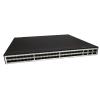
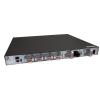
Huawei S6730-H48X6C is an efficient switch from the CloudEngine series. It is equipped with 48 SFP+ slots, each with a throughput of 10 Gb/s, and 6 QSFP28 slots with a throughput of 40/100 Gb/s. The package includes 1 DC power supply and 1 AC power supply. The switch is suitable for
Huawei S6730-H48X6C is an enterprise-class switch from the CloudEngine family. It features 48 SFP+ slots (10 Gbps) and 6 QSFP28 slots (100 Gbps), and stands out with its advanced management capabilities. It offers full routing support, including BGP and BGP4+, MPLS support, and SVF, along with advanced security features. The device can function as a WAC—Wireless Access Controller—allowing it to manage access points directly, which helps reduce the number of devices used in the network. It is designed for ISP applications, as an aggregation switch in large campus networks, or as an access switch in data centers. Thanks to its rich management features and high throughput, the S6730-H48X6C can also serve as the main switch in most smaller networks.
The device features an enclosure designed for installation in a 19" rack, and the package includes the necessary mounting accessories. Active cooling is provided by four fan modules with front-to-back airflow—air is drawn in from the port side and expelled at the rear. The package includes one PAC600S12 power module and one PDC1000S12 power module. These modules can operate redundantly; if one fails, the other takes over. The PAC600S12 supports an input voltage range of 100–240 V AC, while the PDC1000S12 supports -48 to -60 V DC. The switch’s maximum power consumption is 291 W, and typical power consumption at 30% load is 165 W.
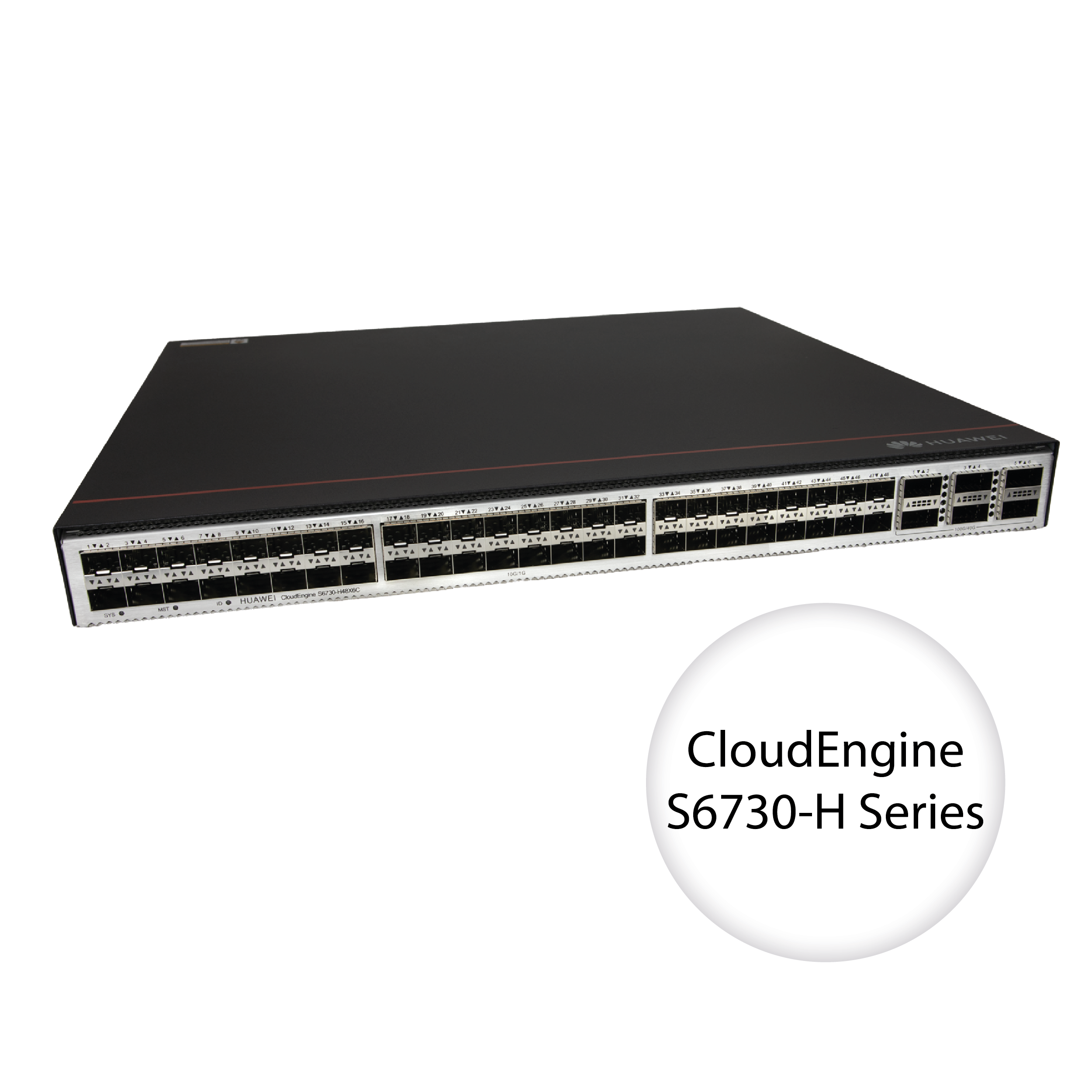
CloudEngine S6730-H Series
The offered product is a switch from the CloudEngine family, specifically the S6730-H series. It provides advanced Layer 3 management features and supports routing, including BGP and BGP4+. It allows real-time monitoring of packet loss and network performance using iPCA technology and the TWAMP protocol. The switch supports VRRP (Virtual Router Redundancy Protocol), enabling the implementation of a backup uplink connection, and can be linked to multiple other switches through various connections.
The device supports iStack—intelligent stacking technology that allows multiple switches to be combined into a single unit from a management perspective. Access to the management interface is available via the cloud or through several other methods (a full list is available in the specifications). The switch also includes numerous security features, providing protection against the most common types of attacks.
WAC Support
The S6730-H can operate as a WAC (Wireless Access Controller), allowing it to manage up to 1,000 access points. It also supports SVF as a parent switch. SVF (Super Virtual Fabric) technology enables the virtualization of a physical network, where a topology composed of core/aggregation switches, access switches, and access points can be virtualized into a single “super switch,” significantly simplifying network management. In large-scale networks, another key advantage is its advanced QoS support, including sophisticated control and queuing algorithms, which ensure high network performance and service quality.
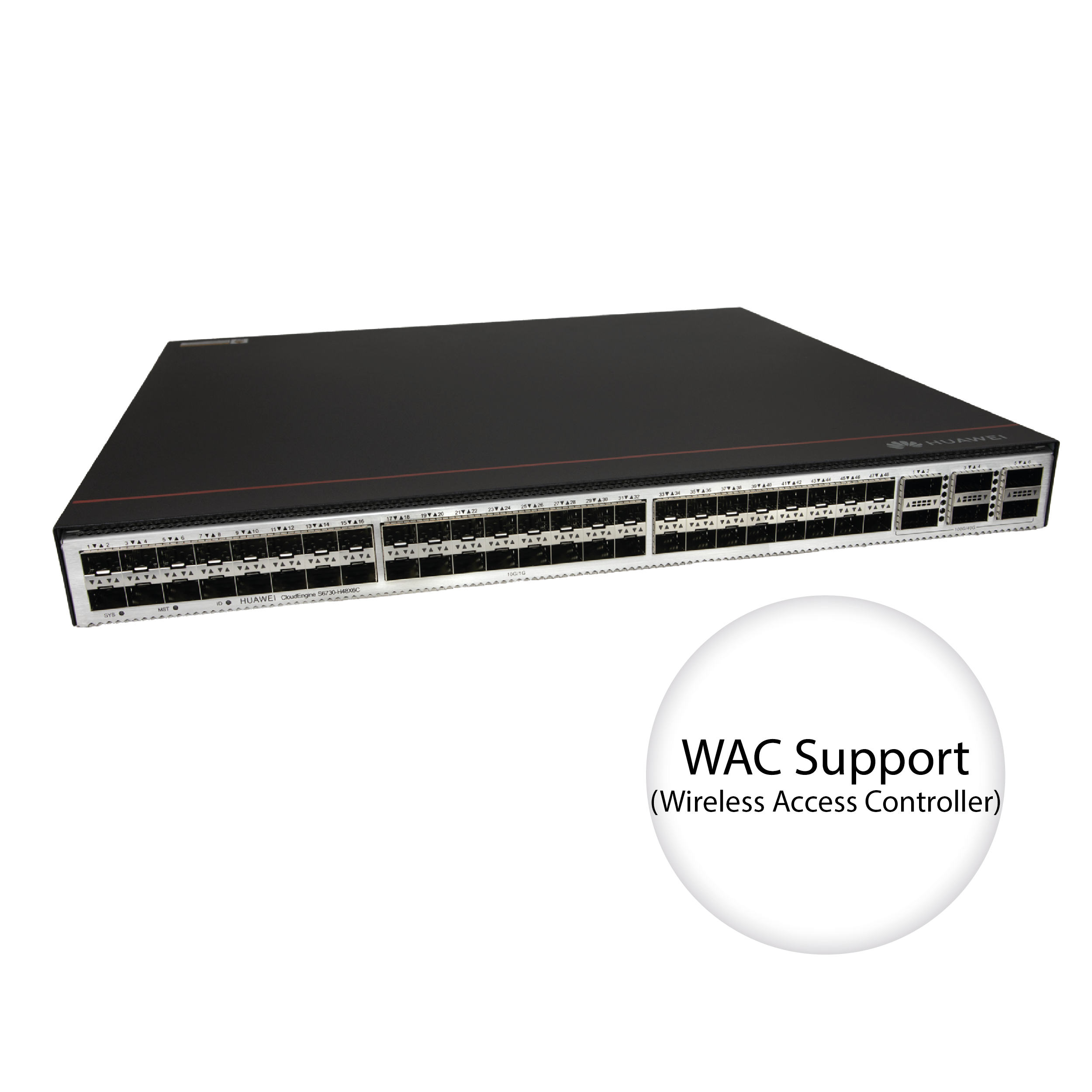
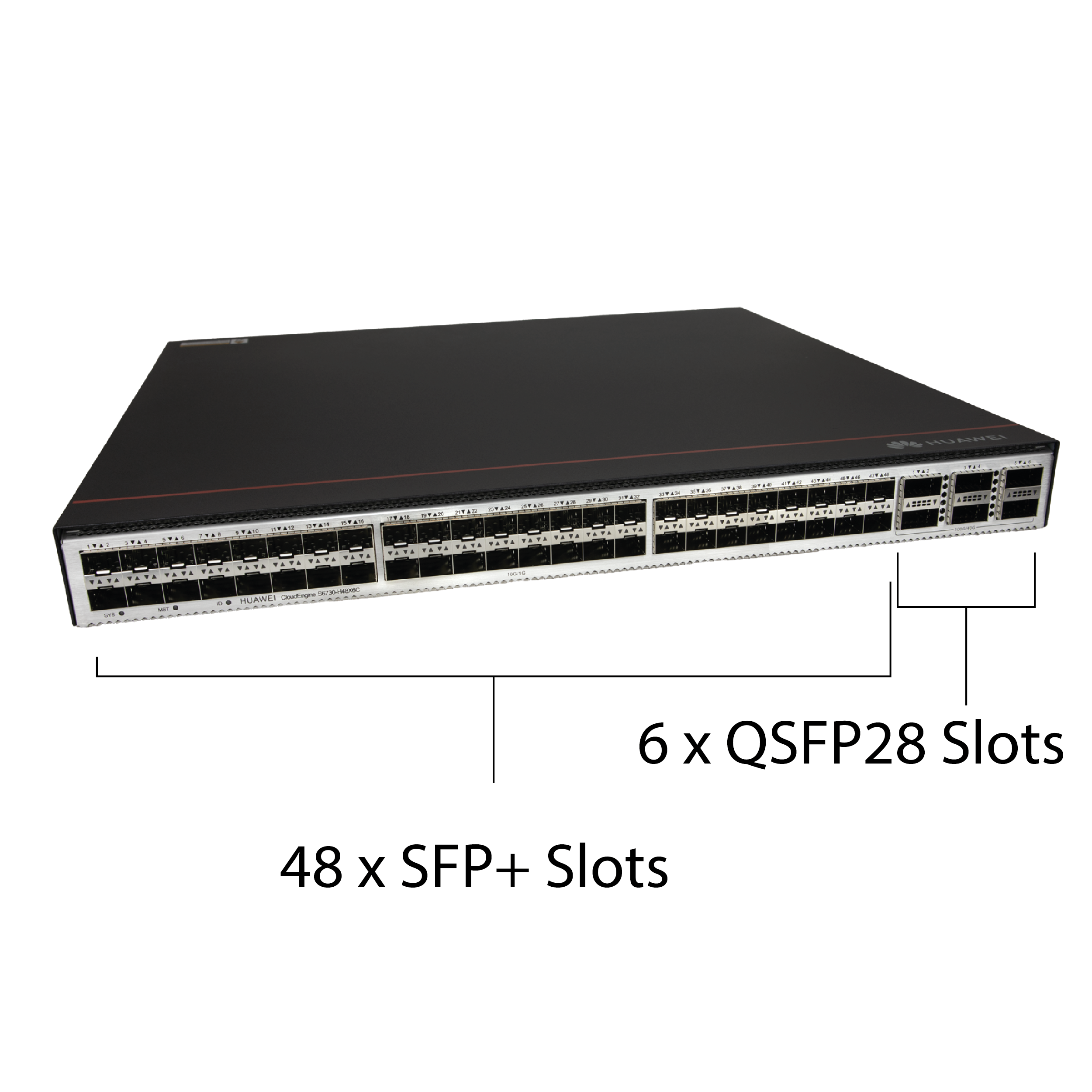
48 SFP+ Slots, 6 QSFP28 Slots
The switch features 48 SFP+ slots with a throughput of 10 Gbps each, and 6 QSFP28 slots supporting 100 Gbps. The total switching capacity reaches an impressive 2.16 Tbps. The device is capable of handling extremely high traffic volumes while maintaining smooth network performance. The S6730-H48 is an excellent solution for environments where the core network infrastructure is based on 10 Gbps connectivity.
One AC Power Supply, One DC Power Supply
The package includes two different power modules: PAC600S12 and PDC1000S12, designed for redundant operation (1+1 power backup). If one power supply fails, the other takes over. The input voltage range for the PAC600S12 is 100–240 V AC, while the input voltage range for the PDC1000S12 is -48 to -60 V DC. The switch’s maximum power consumption under full load is 291 W, and typical power consumption at 30% load is 165 W. The use of a DC power supply is ideal for locations where a backup power supply or telecom power system is available in the rack.
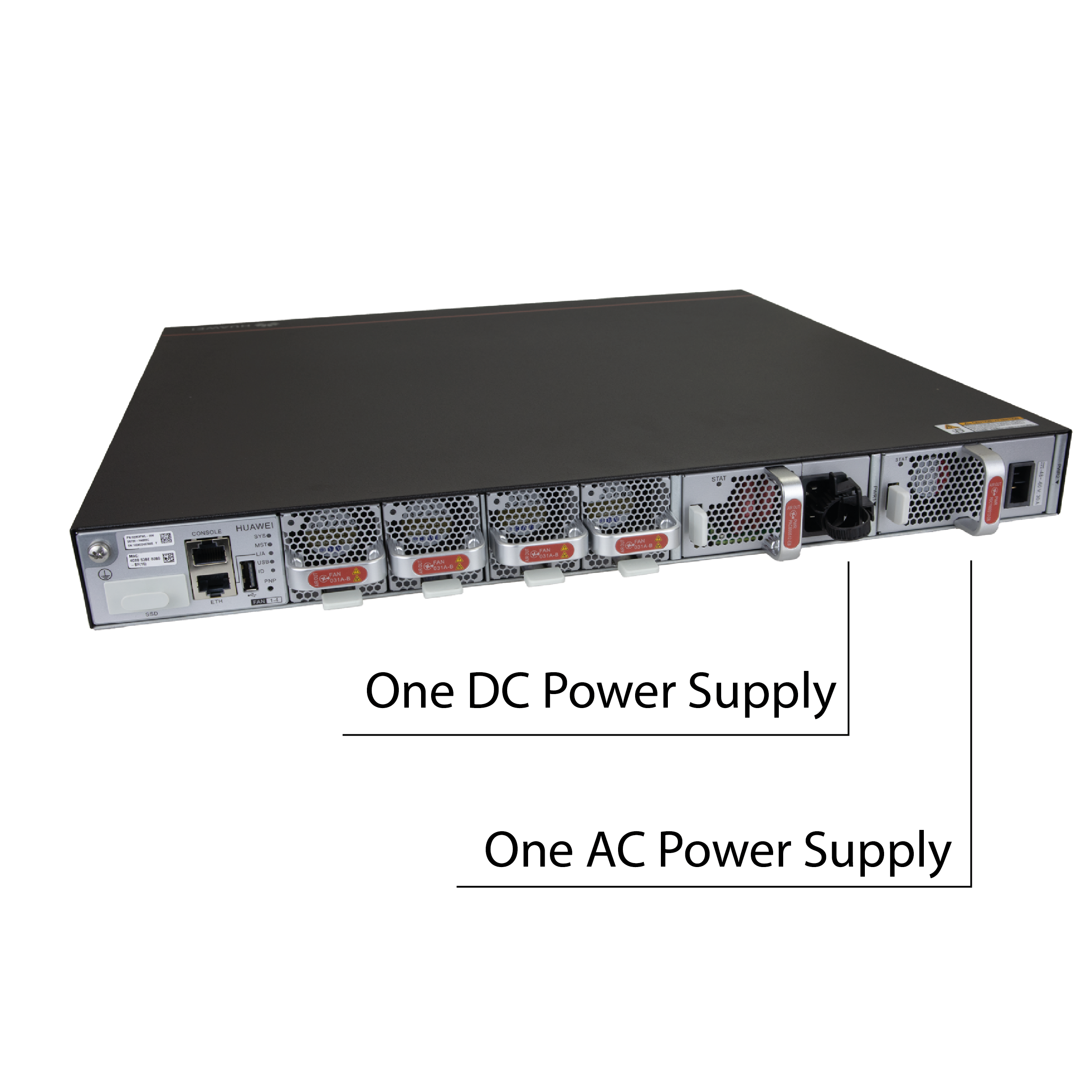

Active Cooling, 19" Rack Enclosure
The switch comes with a 19" rack-mountable enclosure, with a height of 1U. The package includes the necessary mounting accessories. The device features four fan modules that provide active cooling during operation. Each module can be quickly replaced without disassembling the entire enclosure. The installed fans support front-to-back airflow—air is drawn in from the port side and expelled at the rear of the switch.
Application
Thanks to its advanced management capabilities and high throughput, the offered product is well-suited for a wide range of network environments. One of its primary use cases is deployment in internet service provider networks, especially in MAN (Metropolitan Area Network) infrastructures. The device also performs effectively as an aggregation switch in campus networks, where it can additionally serve as an access point controller. Another possible use case is as an access switch in various types of data centers. Regardless of the scenario, the S6730-H is a device that many administrators and users will appreciate.

Specifications
| Huawei S6730-H48X6C | |
| Fixed ports |
48 x 10 Gig SFP+ 6 x 40/100 Gig QSFP28 |
| License |
100 Gb/s N1 Basic Software |
| Dimensions (H x W x D) | 43.6 mm x 442.0 mm x 420.0 mm (1.72 in. x 17.4 in. x 16.5 in.) |
| Chassis height(U) | 1U |
| Voltage |
Rated voltage range AC: 100 V AC to 240 V AC, 50/60 Hz Rated voltage range DC: -48 V DC to -60 V DC Maximum voltage range AC: 90 V AC to 290 V AC, 45 Hz to 65 Hz Maximum voltage range DC: -38.4 V DC to -72 V DC |
| Maximum input current |
AC: 600 W, 8 A DC: 1000 W, 30 A |
| Typical power consumption (30% of traffic load, tested according to ATIS standard) | 165 W |
| Maximum power consumption (100% throughput, full speed of fans) | 291 W |
| Operating temperature | -5°C to +45°C (23°F to 113°F) at an altitude of 0-1800 m (0-5906 ft.) |
| Storage temperature | -40°C to +70°C (-40°F to +158°F) |
| Noise (sound pressure at normal temperature) | < 65 dB(A) |
| Power supply surge protection |
AC: ±6 kV in differential mode, ±6 kV in common mode DC: ±2 kV in differential mode, ±4 kV in common mode |
| Power supply type |
1x 600 W AC Power Module 1x 1000 W DC Power Module |
| Relative humidity | 5% to 95%, noncondensing |
| Fans | 4, Fan modules are pluggable |
| Heat dissipation | Heat dissipation with fan, intelligent fan speed adjustment |
| Service Features | |
|---|---|
| MAC |
Up to 384K MAC address entries IEEE 802.1d standards compliance MAC address learning and aging Static, dynamic, and blackhole MAC address entries Packet filtering based on source MAC addresses |
| VLAN |
4K VLANs Guest VLANs and voice VLANs GVRP MUX VLAN VLAN assignment based on MAC addresses, protocols, IP subnets, policies, and ports VLAN mapping |
| ARP |
Static ARP Dynamic ARP |
| IP routing |
Static routes, RIP v1/2, RIPng, OSPF, OSPFv3, IS-IS, IS-ISv6, BGP, BGP4+, ECMP, routing policy Up to 256K FIBv4 entries Up to 80K FIBv6 entries |
| Interoperability | VLAN-Based Spanning Tree (VBST), working with PVST, PVST+, and RPVST |
| Wireless service |
AP access control, AP domain management, and AP configuration template management Radio management, unified static configuration, and dynamic centralized management WLAN basic services, QoS, security, and user management |
| Ethernet loop protection |
RRPP ring topology and RRPP multi-instance Smart Link tree topology and Smart Link multi-instance, providing millisecond-level protection switchover SEP ERPS (G.8032) BFD for OSPF, BFD for IS-IS, BFD for VRRP, and BFD for PIM STP (IEEE 802.1d), RSTP (IEEE 802.1w), and MSTP (IEEE 802.1s) BPDU protection, root protection, and loop protection |
| MPLS |
MPLS L3VPN MPLS L2VPN (VPWS/VPLS) MPLS-TE MPLS QoS |
| IPv6 features |
Neighbor Discover (ND) PMTU IPv6 Ping, IPv6 Tracert, IPv6 Telnet ACLs based on source IPv6 addresses, destination IPv6 addresses, Layer 4 ports, or protocol types Multicast Listener Discovery snooping (MLDv1/v2) IPv6 addresses configured for sub-interfaces, VRRP6, DHCPv6, and L3VPN |
| Multicast |
IGMP v1/v2/v3 snooping and IGMP fast leave Multicast forwarding in a VLAN and multicast replication between VLANs Multicast load balancing among member ports of a trunk Controllable multicast Port-based multicast traffic statistics IGMP v1/v2/v3, PIM-SM, PIM-DM, and PIM-SSM MSDP Multicast VPN |
| QoS / ACL |
Rate limiting in the inbound and outbound directions of a port Packet redirection Port-based traffic policing and two-rate three-color CAR Eight queues on each port DRR, SP, and DRR+SP queue scheduling algorithms WRED Re-marking of the 802.1p and DSCP fields of packets Packet filtering at Layer 2 to Layer 4, filtering out invalid frames based on the source MAC address, destination MAC address, source IP address, destination IP address, TCP/UDP source/destination port number, protocol type, and VLAN ID Queue-based rate limiting and shaping on ports |
| Security |
Hierarchical user management and password protection DoS attack defense, ARP attack defense, and ICMP attack defense Port isolation, port security, and sticky MAC MAC Forced Forwarding (MFF) Blackhole MAC address entries Limit on the number of learned MAC addresses IEEE 802.1X authentication and limit on the number of users on a port AAA authentication, RADIUS authentication, and HWTACACS authentication NAC SSH V2.0 HTTPS CPU protection Blacklist and whitelist Attack source tracing and punishment for IPv6 packets such as ND, DHCPv6, and MLD packets IPSec for management packet encryption ECA Deception |
| Reliability |
LACP E-Trunk Ethernet OAM (IEEE 802.3ah and IEEE 802.1ag) ITU-Y.1731 DLDP LLDP BFD for BGP, BFD for IS-IS, BFD for OSPF, BFD for static routes |
| SVF |
Acting as the parent node to vertically virtualize downlink switches and APs as one device for management Two-layer client architecture ASs can be independently configured. Services not supported by templates can be configured on the parent node. Third-party devices allowed between SVF parent and clients |
| IPCA |
Marking service packets to obtain the packet loss ratio and number of lost packets in real time Measurement of the number of lost packets and packet loss ratio on networks and devices |
| Management and maintenance |
Cloud-based management Virtual cable test SNMP v1/v2c/v3 RMON Web-based NMS System logs and alarms of different severities GVRP MUX VLAN IEEE 802.3az Automatic power adjustment on Ethernet interfaces NetStream Telemetry |
use by internet service providers, in school campuses, or various institutions.
The offered product supports advanced multicast features, including PIM-SM, PIM-DM, PIM-SSM, and Multicast VPN. It also has extensive Layer 3 functions such as RIP v1/2, OSPF, OSPFv3, IS-IS, IS-ISv6, BGP, and BGP4+. An additional advantage is its numerous security features, detecting non-standard and potentially dangerous traffic, analyzing threats in encrypted traffic (Encrypted Communication Analytics), and can cooperate with the Huawei Cybersecurity Intelligence System (CIS).
Another advantage is the ability to virtually stack multiple switches using iStack. The device supports VXLAN-based virtualization, allowing the connection of wireless and wired networks. It can handle up to 1024 access points in one network, serving as their controller (including domain management and configuration templates).
The switch comes with a license for 100 Gb/s throughput!
Najwa?niejsze cechy:
- 48 SFP+ slots
- 6 QSFP28 slots (40/100 Gb/s)
- 100 Gb/s license
- Ability to connect wired and wireless networks
- Virtual stacking
- VXLAN support
- Numerous security features
Specifications
| S6730-H48X6C | |
| Ports |
48 x 10 Gig SFP+, 6 x 40/100 Gig QSFP28 |
| Licence | 40 Gb/s |
| Dimensions (H x W x D) | 43.6 mm x 442.0 mm x 420.0 mm |
| Chassis height(U) | 1 U |
| Rated voltage range |
AC input: 100 V AC to 240 V AC, 50/60 Hz High-Voltage DC input: 240 V DC DC input: -48 V DC to -60 V DC |
| Maximum input current |
AC 600W?8A DC 1000W?30A |
| Maximum power consumption (100% throughput, full speed of fans) | 291 W |
| Typical power consumption (30% of traffic load, tested according to ATIS standard) | 165 W |
| Operating temperature | -5°C to 45°C |
| Storage temperature | -40°C to +70°C |
| Noise | < 65 dB(A) |
| Power supply surge protection |
Using AC power modules: ±6 kV in differential mode, ±6 kV in common mode Using DC power modules: ±2 kV in differential mode, ±4 kV in common mode |
| Relative humidity | 5%-95% noncondensing |
| Cooling | Active, 4, Fan modules are pluggable |
| W?a?ciwo?ci oprogramowania | |
|---|---|
| MAC |
Up to 384K MAC address entriesIEEE 802.1d standards complianceMAC address learning and agingStatic, dynamic, and blackhole MAC address entriesPacket filtering based on source MAC addresses |
| VLAN |
4K VLANs Guest VLANs and voice VLANs GVRP MUX VLAN VLAN assignment based on MAC addresses, protocols, IP subnets, policies, and ports VLAN mapping |
| ARP | Static ARP/Dynamic ARP |
| IP routing |
Static routes, RIP v1/2, RIPng, OSPF, OSPFv3, IS-IS, IS-ISv6, BGP, BGP4+, ECMP, routing policyUp to 256K FIBv4 entries, Up to 80KFIBv6 entries |
| Interoperability |
VLAN-Based Spanning Tree (VBST), working with PVST, PVST+, and RPVST Link-type Negotiation Protocol (LNP), similar to DTP VLAN Central Management Protocol (VCMP), similar to VTP |
| Wireless service |
AP access control, AP domain management, and AP configuration template management Radio management, unified static configuration, and dynamic centralized management WLAN basic services, QoS, security, and user management CAPWAP, tag/terminal location, and spectrum analysis |
| Ethernet loop protection |
RRPP ring topology and RRPP multi-instance Smart Link tree topology and Smart Link multi-instance, providing millisecond-level protection switchover SEP ERPS (G.8032) BFD for OSPF, BFD for IS-IS, BFD for VRRP, and BFD for PIM STP (IEEE 802.1d), RSTP (IEEE 802.1w), and MSTP (IEEE 802.1s) BPDU protection, root protection, and loop protection |
| MPLS |
MPLS L3VPN MPLS L2VPN (VPWS/VPLS) MPLS-TE MPLS QoS |
| IPv6 features |
Neighbor Discover (ND) PMTU IPv6 Ping, IPv6 Tracert, IPv6 TelnetACLs based on source IPv6 addresses, destination IPv6 addresses, Layer 4 ports, or protocol types Multicast Listener Discovery snooping (MLDv1/v2) IPv6 addresses configured for sub-interfaces, VRRP6, DHCPv6, and L3VPN |
| Multicast |
IGMP v1/v2/v3 snooping and IGMP fast leave Multicast forwarding in a VLAN and multicast replication between VLANs Multicast load balancing among member ports of a trunk Controllable multicast Port-based multicast traffic statistics IGMP v1/v2/v3, PIM-SM, PIM-DM, and PIM-SSM MSDP Multicast VPN |
| QoS / ACL |
Rate limiting in the inbound and outbound directions of a port Packet redirection Port-based traffic policing and two-rate three-color CAR Eight queues on each port DRR, SP, and DRR+SP queue scheduling algorithms WRED Re-marking of the 802.1p and DSCP fields of packets Packet filtering at Layer 2 to Layer 4, filtering out invalid frames based on the source MAC address, destination MAC address, source IP address, destination IP address, TCP/UDP source/destination port number, protocol type, and VLAN ID Queue-based rate limiting and shaping on ports |
| Security |
Hierarchical user management and password protection DoS attack defense, ARP attack defense, and ICMP attack defense Binding of the IP address, MAC address, port number, and VLAN ID Port isolation, port security, and sticky MAC MAC Forced Forwarding (MFF) Blackhole MAC address entries Limit on the number of learned MAC addresses IEEE 802.1X authentication and limit on the number of users on a port AAA authentication, RADIUS authentication, and HWTACACS authentication NAC SSH V2.0 HTTPS CPU protection Blacklist and whitelist Attack source tracing and punishment for IPv6 packets such as ND, DHCPv6, and MLD packets IPSec for management packet encryptionECA Deception |
| Reliability |
LACP E-Trunk Ethernet OAM (IEEE 802.3ah i IEEE 802.1ag) ITU-Y.1731 DLDP LLDP BFD for BGP, BFD for IS-IS, BFD for OSPF, BFD for static routes |
| VXLAN |
VXLAN L2 and L3 gateways Centralized and distributed gateway BGP-EVPN Configured through the NETCONF protocol |
| SVF | Acting as the parent node to vertically virtualize downlink switches and APs as one device for management Two-layer client architecture ASs can be independently configured. Services not supported by templates can be configured on the parent node. Third-party devices allowed between SVF parent and clients |
| IPCA | Marking service packets to obtain the packet loss ratio and number of lost packets in real time Measurement of the number of lost packets and packet loss ratio on networks and devices |
| Management and maintenance |
Cloud-based management Virtual cable test SNMP v1/v2c/v3 RMON Web-based NMS System logs and alarms of different severities GVRPMUX VLAN NetStream Telemetry |






 Polski
Polski English
English Italiano
Italiano Español
Español Čeština
Čeština Српски
Српски Deutsch
Deutsch Ελληνικά
Ελληνικά Slovenský
Slovenský




